
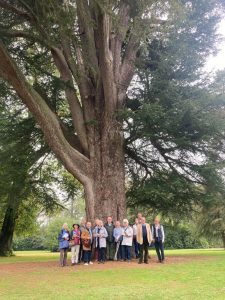
Our long trip this season was to the County of Wiltshire with a full schedule of visits to enjoy. Our journey to our base near Corsham involved a slight dog-leg via Salisbury, to visit the ancient and supremely impressive cathedral. The building is a beautiful example of [perpendicular] architecture with an immensely long arching nave. Although in a different county, ties to Kent were immediately obvious with the memorial tablets to members of the Bouverie and Radnor families, both with Folkestone connections.
Our base was the Guyers House, a charming country house hotel, where the atmosphere, surroundings and the hospitality exceeded our expectations; it proved a very comfortable base for our group – albeit with a challenge for Gareth, our excellent coach driver, who had, daily to demonstrate his coach management skill when entering and exiting lanes, drives and gateposts that were it seemed only inches wider than the coach itself!
Tuesday took us all day to Bowood House and Gardens. We were greeted by Lord Lansdowne who also joined a wander through the 4-acre walled garden and out into the Parkland which extends to 100 acres and was originally landscaped by capability Brown. We were directed to some very impressive trees, including a Wollemi Pine (a species discovered living in only one small area of Australia) which may be the tallest in the UK; to 3 Cedar of Lebanon trees, originally planted in 1768 when the park was laid out, and may be the tallest in the UK.
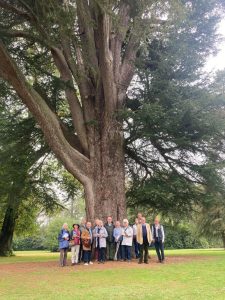
In addition to the parkland, we were guided through the house, to admire the style and grace of the rooms, as well as the impressive collection of items from the Lansdowne collection, many related to time spent as Viceroy of India.
Wednesday took us to the arboretum, modest in acreage but impressive, on the estate of Oare House. Michael was our guide, and as he has been the curator of the arboretum for 30 years, his knowledge and enthusiasm were plain to see. The arboretum is a mixture of earlier planting from the 1920’s and more numerous planting by Michael from the 1990’s. Amongst the many interesting trees were a number of county and national champions, including the Cedar Elm Ulmus Crassifolia, Magnolia Pegasus, Pieris Forest Flame, Algerian Pear Pyrus Cossonii, which carries the tiny cherry-sized fruit we could see. One particular tree – Henry’s Lime Tilia Henryana, whose leaves are edged with impressive “teeth”, intrigued the group most particularly, as there was a startling autumnal Lammas growth, only seen occasionally when conditions are favourable.
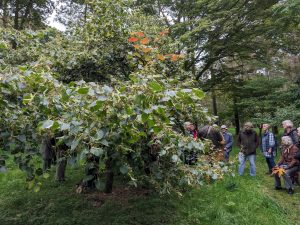
Michael admitted that making space for new plantings was an issue and – with consent from the owners – he was placing some trees of interest outside the arboretum in the parkland, which is primarily planted with 8 species of native tree, in copses, and spaced to maintain views from the Pagoda.
The afternoon was spent at Corsham Court, where Angus, again a member of the owner family, still lives in the building. Most immediately impressive was a Clouded yew hedge first planted in the 1840’s, the beautiful rolling shape of which is maintained by annual clipping; it was our pleasure that this work had just been completed! The grounds of Corsham Court contain many Yew trees, some of which had originally been planted by Capability Brown. Equally impressive was a splendid weeping Copper Beech Tree Fagus sylvatica pendula purpurea a most impressive Indian Bean Tree Catalpa bignonioides and a splendid Black Walnut Juglans nigra
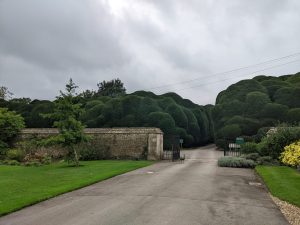
Thursday morning we visited the well-known National Trust estate at Stourhead, where our guides were most informative and helpful. Of note from a tree perspective were the 600-year old sweet chestnut trees, pollarded at 2 metres , some of the best Autumn colour we had seen on the trip ( less than expected due to the continuing warm weather)a Red Oak Quercus rubra planted in 1724 , and a Tulip Tree Liriodendron tulipifera, planted in 1802, amongst many others.
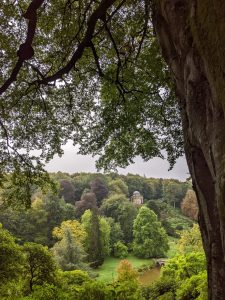
At Stourhead the landscaped gardens provide a classic example of the art of the designer – to provide “Surprise, Variety and Concealment”, which was very evident as we followed the trail around the lake revealing and then hiding features such as the Temple of Apollo, the Grotto and indeed the lake itself!
Our most adventurous outing was the visit to Longleat – to view the park and trees, rather than the animals! We were guided by information provided by Owen Johnson, and our visit intended to find both Heaven’s Gate – for a walk through an area of the estate with mature trees to a viewpoint over the parkland from a good, raised perspective – and then to Gamblers Clump to find some exceptional Coastal Redwood trees and copper beech trees. Heaven’s Gate proved very successful, even when the air was slightly misty; the view was magnificent! Very pleasing also was to find a memorial stone commemorating the actions of a – now defunct – branch of the Men of the Trees! Our venture to find Gamblers Clump was more speculative; I can report that we found, and appreciated, some very well-grown trees, and Owen Johnson has kindly confirmed that we seem to have hit the Bulls-eye and hugged the Champion Coast Redwood Sequoia sempervirens!
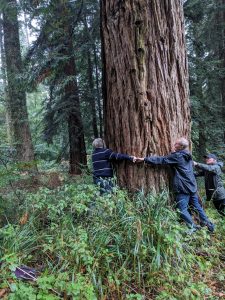
Our last day travel back home was punctuated by a visit to Laycock Abbey, again a National Trust property, where we were able to wander around in the gardens at will and to visit the Abbey and the Fox talbot photography museum and exhibition , all of which proved very interesting and prepared the way for the most generous lunch set out for the group at the Red Lion pub in the village. Having tucked in, the trip back home was trouble-free, thanks to our excellent driver, Gareth.

